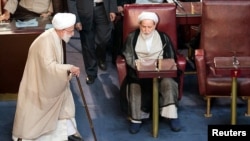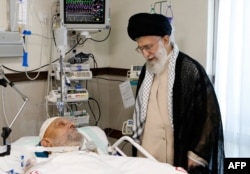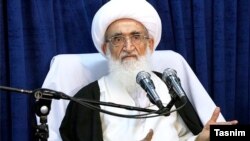News about Ayatollah Mahmoud Hashemi Shahroudi being “almost dead”, as well as the news blackout concerning terminal illness of senior Assembly of Expert member Ayatollah Mohammad Momen once again have brought into spotlight the mystery about the Islamic Republic's ailing and aging officials who never retire.
As anecdotes on social media and small talk among passengers on Tehran's public transport has it, they remain in office until death does them part from their seats.
According to Fararu news website, Momen is 78 years old. Ahmad Jannati who holds several top positions including the head of Guardian Council is 92, prominent cleric Ayatollah Shobeiri Zanjani is 91, Ayatollah Nouri Hamadani is 93, Ayatollah Jafar Sobhani is 90, and in fact Shahroudi, 70, is or was one of the youngest clerics holding official positions in the Islamic Republic.
There have been clerics such as Mohammad Reza Mahdavi Kani who held tightly to their post even after months of being in a state of coma. He died in 2014 while still the chairman of Assembly of experts. Of course, this was rather a sign of indecision by Supreme Leader Khamenei who probably found it hard to trust anyone else.
Clerics are not the only officials who wish to remain in their posts until their death. While the average age of President Akbar Hashemi Rafsanjani's first cabinet was 41, and his second cabinet was 44, Prssident Mohammad Khatami's cabinets were 44 and 47 years old on average, and President Mahmoud Ahmadinjad's cabinents were 49 and 50 years old. In the first cabinet of President Hassan Rouhani the ministers' average age was 61 according to hardline Mashregh News website. His second cabinet was slightly younger because he introduced one minister who was in his 30s and this brought the average age of Rouhani's second cabinet to only 58, reported fact-checking website Fact Nameh.
In fact Iranian state officials have been growing older and older since 1979. One reason is that many, including Khamenei and Rouhani, who started their careers with the Islamic Republic's first government in 1979, are still holding top positions.
Even after a law was passed in 2018 to bar individuals past retirement age from holding government positions, Khamenei complained that officials wrote to him to allow some kind of exemption that would keep them in their positions.
On the other hand there is a fierce resistance against introducing new faces into the senior government posts or the non-elected institutions such as the Guardian Council and Expediency Discernment Council. It can also be a matter of trust. Iranian leaders fear new faces as they cannot trust them. This comes while trust built between individuals such as Khamenei and Rafsanjani over 50 years was eroded in the course of political upheavals created by their conflicting interests.
In the case of Shahroudi, while Expediency Discernment Secretary Mohsen Rezai (64) has been putting his name forward and in fact grooming himself for the top post in the council as the news of Shahroudi's illness became widespread in 2017, Khamenei first appointed Movahedi Kermani (87) and the Jannati (92) as the substitute chairmen of the council.
The Islamic Republic's Old Guard has been always reluctant to open room for the younger generation of clerics and technocrats to take over the government and dozens of non-elected posts at state organizations.
However, with nearly all state officials, particularly clerics being well above retirement age with many in their 80s and 90s, it will be inevitable for the next generation to take over at one point.
Meanwhile, the death of Shahroudi, of one of the most likely persons to succeed Khamenei as Iran's new Supreme Leader, will once again remind everyone in the political elite to think of other possible nominees for the post. This task harder would be harder than ever owing to the widening gaps between key political figures and factions in Iran over what direction the country should take in the future.





